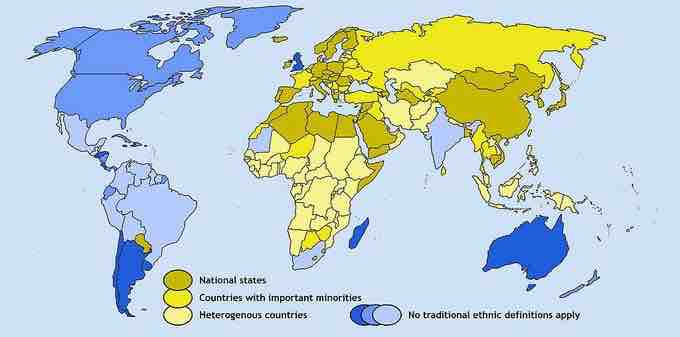The Value of Diversity
Globalization has resulted in enormous cross-cultural relationships, along with high percentages of domestic diversity. As globalization creates higher potential value in approaching diverse markets and demographics, understanding how to manage a diverse community internally is a priority for management.
Through creating a more international community and increasing variety among workforces, companies stand to benefit enormously from meaningful diversity in opinions and perspectives. This opportunity, if not properly utilized, becomes a threat as the competition grows more effective at leveraging diversity to create synergy. Therefore, staying competitive requires the creation of an effectively diverse workplace.

Ethnic diversity map
This map illustrates the level of diversity worldwide. Areas like sub-Saharan Africa tend to be more heterogenous than, for instance, states in Europe.
Stemming from various legislative initiatives in the 1960s, the concept of equality and a fair distribution of opportunity became a domestic focus in the United States. As the decades passed, this focus shifted from a legal requirement to a social expectation. Finally the idea of equality became a societal norm that recognizes both the importance and the value of diversity. This evolving outlook on a diverse workplace has ultimately resulted in the recognition and implementation of diversity management and intercultural understandings within organizations, creating stronger and more ethical business practices.
Challenges of Diversity
Despite this successful trajectory, challenges to diversity naturally occur as a result of communication (languages and values), majority hegemony, and groupthink.
Communication
Communication is at the heart of diversity management, but not necessarily for obvious reasons. Linguistic differences, while certainly a challenge, are tangible and straightforward. Learning new languages or translating materials is a reasonably effective approach to addressing these difficulties.
The more difficult challenge is the intangibles in communication that arise not from literal words but from cultural expectations. Different cultures not only speak different languages but adhere to different values, draw different assumptions, and define different actions as appropriate or inappropriate. Overlooking these cultural differences can result in miscommunication that may go unrecognized. For example, in China it is quite important to understand the concept of guanxi (face), particularly as it pertains to paying respect to guests or superiors. Overlooking these customs sends unintentional messages that can do irreversible damage.
Majority Hegemony
Majorities in businesses creating a homogeneous culture is also a substantial threat, as company culture is a direct product of the participants (employees). This can result in a business that creates and promotes a particular culture over other minority cultures, usually unintentionally as a result of numbers. This hegemony can create tension between different groups, ultimately resulting in the smaller groups moving towards the culture of the larger ones to close the dissonance, a practice called assimilation. Assimilation should be a shared responsibility, not simply assumed by those in the minority group.
Groupthink
The most substantial threat these communicative barriers and homogeneous tendencies create could loosely be defined as groupthink. Groupthink is when many people within the same organization begin to adopt similar perspectives, usually to simplify meetings and minimize discord. On the surface, this consensus sounds like a good thing. However, as the global economy requires businesses to understand varying perspectives, it also necessitates the cultivation of these diverse perspectives internally. Groupthink will often result in the assimilation of dissenting perspectives. The opportunity cost is precisely these different viewpoints. Without differences in perspective, companies have little room to expand into new demographics or innovate new solutions.
The Role of Management
Different cultural norms offer an interesting study in diversity management. Etiquette for receiving a business card in China requires accepting it with both hands and taking a full moment to read it. Following this, recipients place the card face up on the table in front of them during the meeting, referring to it when necessary. In the U.S., a strong handshake and self-introduction is a polite start to a meeting. Conversely, in Japan, it is appropriate to wait to be introduced and then bow following the greeting.
Managers must be not only aware of diversity in the workplace but also open-minded and empathetic to perspectives other than their own. Effective managers in diverse situations have a highly developed degree of cultural competence that empowers them to use careful observation skills to determine what gestures, phrases, customs and values would be most appropriate in a given circumstance. Adroit management must also work actively against groupthink, empowering everyone not only to speak but to be brave enough to go against the majority opinion. The goal for management is to ensure everyone is working to assimilate to everyone else in a balanced and effective manner that harvests differences rather than smoothing them over.t
Example
Different cultural norms offer an interesting study in diversity management. Etiquette for receiving a business card in China requires accepting it with both hands and taking a full moment to read it. Following this, recipients place the card face up on the table in front of them during the meeting, referring to it when necessary. In the U.S., a strong handshake and self-introduction is a polite start to a meeting. Conversely, in Japan, it is appropriate to wait to be introduced and then bow following the greeting.